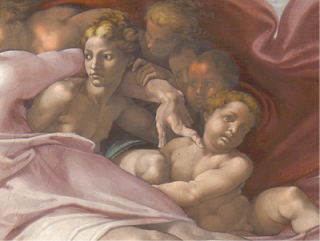The language is that of road-building, though Luke left that part out when quoting the prophet. In the gospel reading for Advent 2C (Luke 3:1-6), Luke says:
...as it is written in the book of the words of the prophet Isaiah, “The voice of one crying out in the wilderness: ‘Prepare the way of the Lord, make his paths straight. Every valley shall be filled, and every mountain and hill shall be made low, and the crooked shall be made straight, and the rough ways made smooth; and all flesh shall see the salvation of God.’” The "original" is:
A voice cries out: ‘In the wilderness prepare the way of the Lord, make straight in the desert a highway for our God. Every valley shall be lifted up, and every mountain and hill be made low; the uneven ground shall become level, and the rough places a plain. Then the glory of the Lord shall be revealed, and all people shall see it together, for the mouth of the Lord has spoken.’ (Isaiah 40:3-5)
Building roads today may be perceived as easier because of the technological and engineering advances. But, then, along with the engineering advances, the expectations have also risen. Today it isn't enough to carve out a passable track over the natural ridge configuration of a mountain; instead, the mountain must be dynamited out of the way and a more level roadbed laid.
To be sure, the point of the prophetic passage is that the people understand that God is about to (re)enter their lives and a way must be made for that. In the case of Jesus, God will make the way with the incarnation. But the metaphor is that of a road. And roads, whether by God or by humans, must still be built.
A part of the backbreaking process of 19th-century road construction is captured by Gustave Courbet in his work
The Stonebreakers. Courbet, a French artist, established Realism as an anti-academic approach to art in the middle of the 19th century. The picture, treated harshly by many contemporary critics, shows two figures engaged in clearing stones from roadbeds and then breaking them into smaller pieces. The stones were turned into gravel for paving material and other uses.
Gustave Courbet. The Stonebreakers. 1849. Destroyed 1945. Previously Gemaldegalerie, Dresden, Germany.
The two figures are anonymous. We would not be able to recognize either of the two workers should we see them again, but they seem by turns too young and too old to be doing this demanding work. The artist saw the two workers at their task as he was riding in his carriage into the countryside to paint a landscape and was struck by their suitability as a painting subject. He invited them to his studio the following day and began the painting.
Realism refused to idealize any subject, so there is no golden glow of daylight or oneness with nature. There is only work. Pull, swing, chop, load, carry, dump, start over.
Philosopher Pierre-Joseph Proudhon, a friend of Courbet's, wrote of this painting: “Our industrial civilization which everyday invents marvelous machines to labour – to sow, spin, in short to execute all sorts of jobs, is yet incapable of liberating the human being from the grossest, the most repugnant and painful of tasks – the lamentable lot of the poor.”
Though civilization may not have been able to liberate the poor from their "lamentable lot", the coming of Christ was to accomplish just that. And these two workers, one too young, one too old, disregarded by society, certainly among "the least of these", would have been right at home in Luke's gospel with its babies born to women who were too old and too young, with its working shepherds who were unlikely attendees at the manger, with its "blessed are the poor."
Prepare the way of the Lord.

Heeeeere's Malachi! Click on the
Facebook link to find out which of these figures is Malachi and what he is doing in this altarpiece.
For other thoughts on Malachi 3:1-4, click
here.

















































